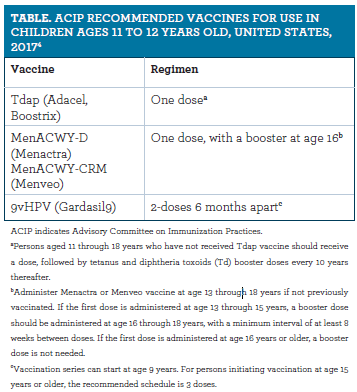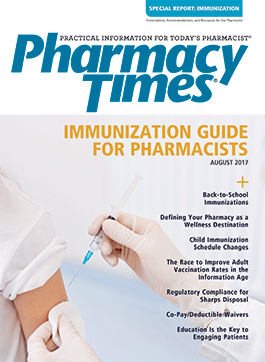Publication
Article
Supplements
Back-to-School Immunizations
Outbreaks of measles, mumps, pertussis (whooping cough), and other vaccine-preventable diseases still occur in the United States.
Outbreaks of measles, mumps, pertussis (whooping cough), and other vaccine-preventable diseases still occur in the United States. In 2014 alone, 27 states reported a total of 667 cases to the CDC, which is the highest number of measles cases since its elimination was documented in the United States in 2000.1
Further, in 2012, more than 41,000 pertussis cases and 18 deaths due to pertussis were reported to the CDC, also the largest number of cases in the United States since 1959.2 Most vaccine-preventable diseases are contagious and can be serious in children and adults with whom they have contact. Therefore, it is important that school-aged children are up-to-date on all annual immunizations prior to each school year.
The American Academy of Pediatrics recommends an annual check-up for children and adolescents aged 3 to 21 years.3 Parents (and caregivers) should be encouraged to schedule their child’s yearly check-up appointment before school starts, as this is a practical time to verify that the child is current on all recommended immunizations. Parents should be informed to ask their child’s doctor about providing age-appropriate vaccines and “catch-up” vaccines at every visit.3 This is especially true when a child is seen for sports and camp physicals or acute care, chronic illness, and follow-up visits.
Depending upon the state, parents may need to show documentation that their child is up-to-date on recommended immunizations at kindergarten (4-6 years) and seventh grade (12-13 years) before they can start school. All states require some vaccines before a child may enter kindergarten. Parents should check with their state’s school requirements, child’s doctor or pharmacist, child’s school, or health department about any state-specific requirements. The Immunization Action Coalition’s website4 also provides information about each state’s immunization mandates. Parents may also be advised to create a personalized immunization schedule for their children using an online tool available on the CDC website.5 Pharmacists can help parents create this document, which can then be shared with the child’s doctor or an immunizing pharmacist.
For all age groups listed below, an annual age-appropriate influenza vaccine should be administered when available.6 Children 6 months through 8 years should get 2 doses 4 weeks apart the first time they receive the influenza vaccine,7 and parents should be advised to ask their child’s doctor or pharmacist if 1 or 2 doses of the influenza vaccine are needed. The live attenuated intranasal influenza vaccine is not recommended to be given to any age group this flu season.6
AGES 4 TO 6 YEARS (KINDERGARTEN)
Children aged 4 through 6 years receive booster doses of previous vaccines, including diphtheria, tetanus, and acellular pertussis (DTaP); polio (IPV); measles, mumps, and rubella (MMR); and chickenpox (Varicella).6 A child who is up-to-date with all vaccines by the age of 6 is protected against 14 vaccine-preventable diseases.8

Children aged 7 to 10 years is used for catch-up immunizations for those who are behind schedule (see the CDC’s Catch-up Immunization schedule).6 It is important to note that lapsed intervals do not necessitate restarting a vaccine series. Children aged 7 through 10 years who have not received any, or all, of the DTaP vaccines series should receive a single dose of the tetanus, diphtheria, and acellular pertussis (Tdap) vaccine as catch-up immunization.6 As part of the catch-up series, these children will also need an additional Tdap dose at age 11 or 12.6
AGES 11 TO 12 YEARS (PRETEENS OR “TWEENS”)
“Too old for the pediatrician, too young for the internist!” Tweens, or those 11 to 12 years of age, are usually healthy and do not receive regular medical care. They are, however, urged to receive 3 vaccines: Tdap, meningococcal (MCV4), and human papillomavirus (HPV).6 These vaccines are important to administer to this age group because pre-teens have a strong immune response that, in the case of HPV, may protect them should they become sexually active. Preteens are also proximate to the age of risk for acquiring these diseases. The HPV9 vaccine is administered in 3 doses, but if it is started before age 15 years, then only administer 2 doses over 6 to 12 months.9 HPV infections may cause certain cancers and genital warts in both men and women.10 Meningococcal disease is spread by respiratory secretions (eg, kissing, coughing, sharing cups); the number of cases tends to peak with college freshmen.11 The MCV4 vaccine is given in 2 doses, ideally 5 years apart.12 Although the rate of meningococcal disease is low and has been declining, young adults, primarily those living in shared spaces such as dorms, continue to die from the disease.
AGES 13 TO 18 YEARS (TEENS)
If the meningococcal conjugate vaccine was administered for the first time at age 13 through 15 years, another dose of the vaccine should be administered when the individual turns 16.12 Some colleges may require meningococcal conjugate vaccine for first-year college students living in residence halls. However, meningococcal disease is not limited to college attendees; therefore, vaccination is a universal recommendation.13 Teens in this age group may also be vaccinated with a serogroup B meningococcal vaccine (2 or 3 doses depending on the brand), preferably between ages 16 and 18.12,14
Some colleges recently reported outbreaks of serogroup B meningococcal disease. The MCV4 vaccines do not offer protection against serogroup B meningococcal disease.13 Therefore, the decision to vaccinate individuals with a serogroup B meningococcal vaccine depends on the vaccine providers’ assessment of the individual’s risk factors (eg, disease outbreaks, damaged or removed spleen, persistent complement immune deficiency, etc).14 There are 2 noninterchangeable meningococcal B vaccines: MenB-FHbp is given as 2 or 3 doses over 6 months and the MenB-4C is given as 2 doses 1 month apart in this age group.13,15
Members of this age group also receive catch-up immunizations if they have fallen behind schedule. This is the last opportunity to catch-up with a routine dose of polio vaccine, before age 18, or hepatitis A vaccine, before age 19.6
PHARMACISTS’ ROLE
While immunization requirements set by the states and schools help to increase vaccination rates, parents may still hesitate to vaccinate their children. They also may not be aware that certain vaccines require more than 1 dose. Pharmacists can help to educate parents about vaccine safety and efficacy, the importance of being up-to-date with childhood vaccinations, and the complex routine of catch-up childhood and adolescent immunization schedules. Although pharmacists have traditionally played an advocate role in pediatric vaccination, they should be active immunizers for tweens and teens, too. HPV vaccination rates are low compared with other vaccinations for this age group. Vaccination rates may improve if all states allow pharmacists to administer the HPV vaccine and pharmacists focused on immunizing this age group. Currently, only 61% of states/territories allow pharmacists to vaccinate pre-teens for HPV.16
CONCLUSION
To increase access to immunizations, pharmacists should become trained to administer vaccines and participate in immunization registries. Pharmacists can administer all vaccines in most states.17 However, the age groups that a pharmacist can immunize vary from state to state. As of July 2015, 27 states allow pharmacists to administer a vaccine to a patient of any age,17 while others allow pharmacists to administer vaccines only to adults 18 and older. In these states, pharmacists should join the American Pharmacists Association or their state’s pharmacy association to advocate for increasing their scope of immunization practice.17
REFERENCES
1. Measles cases and outbreaks. CDC website. cdc.gov/measles/cases-outbreaks. html. Accessed July 5, 2017.
2. Pertussis/whooping cough (Bordetella pertussis) 2014 case definition. CDC website. cdc.gov/measles/cases-outbreaks.html. Updated 2014. Accessed July 27, 2017.
3. Recommendations for preventive pediatric health care. American Academy of Pediatrics website. aap.org/en-us/Documents/periodicity_schedule.pdf. Approved February 2017. Published April 2017. Accessed July 26, 2017.
4. State information. Immunization Action Coalition website. immunize.org/ laws/. Accessed July 31, 2017.
5. Instant childhood immunization schedule. CDC website. 2a.cdc.gov/nip/ kidstuff/newscheduler_le/. Updated February 6, 2017. Accessed July 31, 2017.
6. Recommended immunization schedule for children and adolescents aged 18 years or younger, United States, 2017. CDC website. cdc.gov/vaccines/schedules/ downloads/child/0-18yrs-child-combined-schedule.pdf. Accessed July 26, 2017.
7. Grohskopf LA, Sokolow LZ, Broder KR, et al. Prevention and control of seasonal influenza with vaccines: recommendations of the Advisory Committee on Immunization Practices — United States, 2016—17 influenza season. MMWR Recomm Rep. 2016;65(5):1-54.
8. 2017 Recommended immunizations for children from birth through 6 years old. CDC website. cdc.gov/vaccines/parents/downloads/parent-ver-sch-0-6yrs. pdf. Accessed July 28, 2017.
9. Meites E, Kempe A, Markowitz LE. Use of a 2-dose schedule for human papillomavirus vaccination — updated recommendations of the Advisory Committee on Immunization Practices. MMWR Morb Mortal Wkly Rep. 2016;65(49):1405-1408. doi: 10.15585/mmwr.mm6549a5.
10. Human papillomavirus (HPV): questions and answers. CDC website. cdc. gov/hpv/parents/questions-answers.html. Updated November 28, 2016. Accessed July 27, 2017.
11. Vaccine information statements (VISs): serogroup B meningococcal (MenB) VIS. CDC website. cdc.gov/vaccines/hcp/vis/vis-statements/mening-serogroup. html. Updated August 9, 2016. Accessed July 27, 2017.
12. Cohn AC, MacNeil JR, Clark TA, et al. Prevention and control of meningococcal disease: recommendations of the Advisory Committee on Immunization Practices. MMWR Morb Mortal Wkly Rep. 2013;62 (RR02);1-22.
13. Meningococcal disease: community settings as a risk factor. CDC website. cdc.gov/meningococcal/about/risk-community.html. Updated June 7, 2017. Accessed July 27, 2017.
14. Patton ME, Stephens D, Moore K, MacNeil JR. Updated recommendations for the use of MenB-FHbp serogroup B meningococcal vaccine — Advisory Committee on Immunization Practices, 2016. MMWR Morb Mortal Wkly Rep. 2017;66:509-513.
15. Use of serogroup B meningococcal vaccines in adolescents and young adults: recommendations of the Advisory Committee on Immunization Practices, 2015. CDC website. cdc.gov/mmwr/preview/mmwrhtml/mm6441a3.htm. Published October 23, 2015. Accessed July 28, 2017.
16. Brewer NT, Chung JK, Baker HM, Rothholz MC, Smith JS. Pharmacist authority to provide HPV vaccine: novel partners in cervical cancer prevention. Gynecol Oncol. 2014;132(suppl 1):S3-S8. doi: 10.1016/j.ygyno.2013.12.020.
17. Weaver KK. Pharmacist-administered immunizations: What does your state allow? Pharmacy Today website. pharmacytoday.org/article/S1042- 0991(15)30130-4/pdf. Published October 2015. Accessed July 20, 2017.
Jelena Lewis, PharmD, is an assistant professor of pharmacy practice at Chapman University School of Pharmacy, Irvine, California, and faculty in residence at St. Jude HeritageMedical Group, Fullerton, California.Jeff Goad, PharmD, MPH, is professor and chair, Department of Pharmacy Practice, Chapman University School of Pharmacy, Irvine, California.







